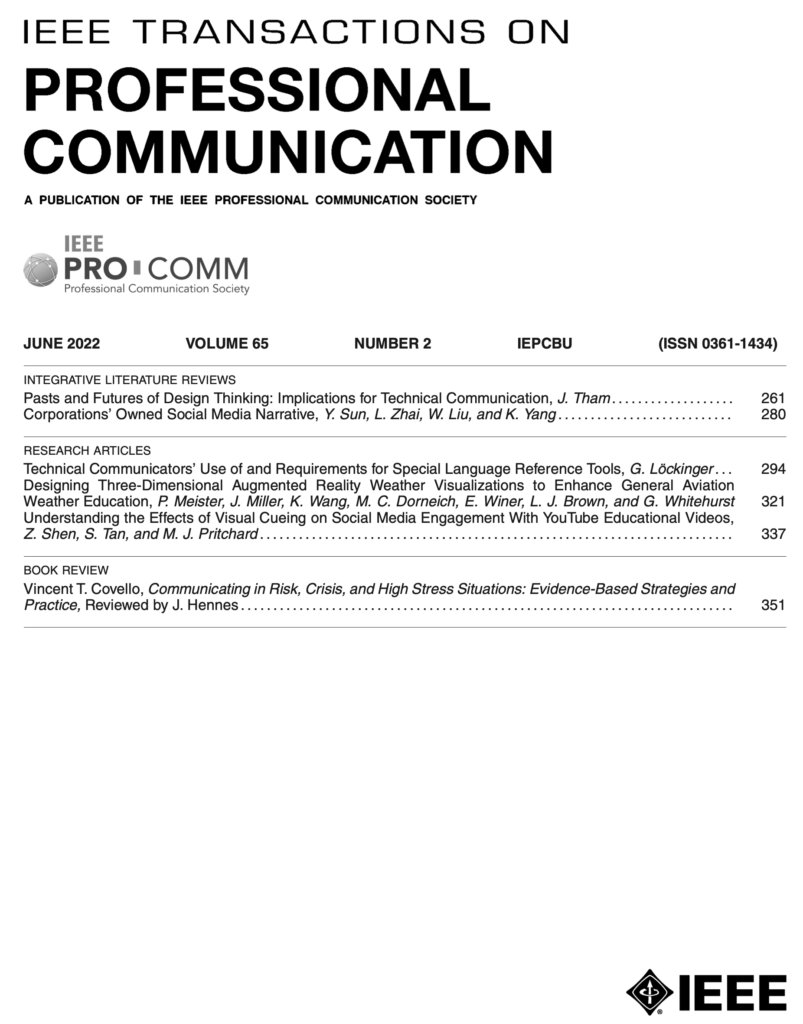The June 2022 issue of IEEE Transactions on Professional Communication is Now Available
06 June, 2022
Published on June 15, 2022
Volume 65, Number 2, June 2022

| Publication of the IEEE Professional Communication Society[Publication Information] Integrative Literature Review |
| Pasts and Futures of Design Thinking: Implications for Technical Communication, by J. Tham Design thinking has gained popularity over the last few decades, yet our increasingly complex sociotechnical climate calls for historical examination of the decades-old problem-solving model and re-envisioning of the prospect of design thinking in academia and industry. This article interrogates the historiography of design thinking by mapping its dominant narratives, and constructs antenarrative futures by weaving adjuvant accounts into new trajectories for technical communication. Based on this mapping, the study presents two root accounts of design-thinking development—the efficiency narrative and the participatory narrative. The findings indicate the importance of social advocacy through two main antenarratives—inclusion and social justice. |
| Corporations’ Owned Social Media Narrative, by Y. Sun, L. Zhai, W. Liu, and K. Yang Corporations’ owned social media narrative (COSMN) has not been systematically investigated. We conducted an integrative literature review of studies on COSMIN based on qualitative content analysis of 25 articles to describe their general characteristics and identify narrative strategies and functions. Advertising, branding, and social networking activities (among others) on social media tend to use form-based narrative strategies (technical strategy and formality strategy), content-based narrative strategies (broadcasting strategy, reacting strategy, engaging strategy, and emotional strategy), and medium-based narrative strategy (transmedia strategy) to achieve functions of market communication, technical communication, and public relations work (identity construction, impression management, stakeholder endorsement, corporate social responsibility communication, and crisis communication). |
| Research Articles: |
| Technical Communicators’ Use of and Requirements for Special Language Reference Tools, by G. Löckinger Numerous studies examine information needs and search techniques of various professionals, but very little is known about technical communicators’ use of and requirements for information sources containing special language information. Survey results indicate that respondents use 14 major types of information sources for researching special language information. Half can be categorized as reference tools, while the other half are document-like. Respondents would like to have special language reference tools that are available electronically, can be adapted to their personal needs, and offer up-to-date information with good usability. The document-like tools can be used as text corpora. Thus, text corpus management methods and tools should be promoted in technical communication practice and teaching. The requirements and wishes described in this article lay the groundwork for developing tailor-made special language reference tools. |
| Designing Three-Dimensional Augmented Reality Weather Visualizations to Enhance General Aviation Weather Education, by P. Meister, J. Miller, K. Wang, M. C. Dorneich, E. Winer, L. J. Brown, and G. Whitehurst A 3D augmented reality (AR) thunderstorm cell lifecycle visualization was designed and developed, and a preliminary evaluation of the application for general aviation weather training was conducted to assess whether the visualization can communicate weather theory and whether the interfaces are usable for learning and task completion. Students’ knowledge of thunderstorms increased after using the visualization to explore the dynamics of the thunderstorm lifecycle and various aspects of thunderstorms. Experts felt that the learning experience met their expectations of what they wanted to communicate about thunderstorm theory. The AR interfaces were rated as usable for learning interactions and produced low levels of workload. The communication of thunderstorm theory was supported by the animation and interactivity, and could enhance current general aviation weather education. |
| Understanding the Effects of Visual Cueing on Social Media Engagement with YouTube Educational Videos, by Z. Shen, S. Tan and M. J. Pritchard Social media have transformative effects on technical communication. Technical communication scholars have attended to the increasing use of social media personally, pedagogically, and professionally. We sampled 196 YouTube educational videos on physics and astronomy topics, and extracted visual cueing from the videos and social media engagement information from YouTube. Our analyses show that intrinsic visual features (color contrast and visual complexity) are significantly related to social media engagement (involvement, intimacy, and interaction), but anchors (math equations and models) are not. Our study supports the empirical knowledge on social media engagement with YouTube educational videos and expands on the technical communication research for YouTube educational videos. |

